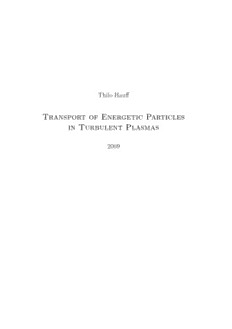
Transport of energetic particles in turbulent plasmas PDF
Preview Transport of energetic particles in turbulent plasmas
Thilo Hau(cid:11) Transport of Energetic Particles in Turbulent Plasmas 2009 Transport of Energetic Particles in Turbulent Plasmas Dissertation zur Erlangung des Doktorgrades Dr. rer. nat. der Fakult(cid:127)at fu(cid:127)r Naturwissenschaften der Universit(cid:127)at Ulm vorgelegt von Thilo Hau(cid:11) aus Ulm 2009 Dekan: Prof. Dr. Axel Gro(cid:25) Erstgutachter: apl. Prof. Dr. Frank Jenko Zweitgutachter: Prof. Dr. Peter Reineker Drittgutachter: Prof. Dr. Tu(cid:127)nde Fu(cid:127)l(cid:127)op Tag der Promotion: 11. November 2009 For we know in part, and we prophesy in part. But when that which is perfect is come, then that which is in part shall be done away. Saint Paul, 1 Cor.13,9-10 Meiner Frau Cornelia gewidmet Abstract Anomalous transport in magnetically con(cid:12)ned fusion plasmas is induced by electrostatic and magnetic turbulence on scales of the Larmor radii of the ions and electrons, and is responsible for the degradation of con(cid:12)nement, strongly complicatingtheprocessofachievingthenecessaryconditionstosustainaburn- ing plasma. The quest to understand the turbulent transport of particles, mo- mentum, and energy in magnetized plasmas remains a key challenge in nuclear fusion research. A basic issue being still relatively poorly understood is the turbulent advection of energetic particles with large drift orbits and gyroradii. Especially the interaction of fast alpha particles or ‘beam ions’ with the back- ground turbulence is of great interest. In this thesis, fast particles are treated as passive test particles, and the connection between decorrelation processes (Eulerian or Lagrangian) and the transition to a di(cid:11)usive regime is shown to be crucial in describing transport processes. To allow for a better understanding of the dependence of the parti- cle di(cid:11)usivity on the interaction mechanisms between the particle trajectories on one hand and the spatio-temporal structure of a certain type of turbulence on the other hand, a three step approach is applied: Numerical studies with arti(cid:12)cially created stream functions in simpli(cid:12)ed geometries are used alongside analytical models, which are eventually con(cid:12)rmed using self-consistent gyroki- neticsimulationswiththeGenecode. Theparticlemotionisinitiallyrestricted to two dimensions and, after having studied the crucial e(cid:11)ects there, extended to three dimensions, where additional e(cid:11)ects come into play. In two dimensions (i.e. in the plane perpendicular to the magnetic (cid:12)eld), (cid:12)nite gyroradius e(cid:11)ects are introduced using the gyroaveraging approximation which means that the gyrating particle is replaced by a charged ring. The Kubonumberandthegyroradiusarefoundtobecrucialparameters,separating di(cid:11)erent regimes of transport scaling. Depending on these parameters, regimes can be foundwherethetransport isindependentof the energy, or showsa more or less steep decline. The underlying physical mechanisms of this behavior are identi(cid:12)ed and an analytical approach is developed which favorably agrees with the simulation results. The investigations are extended by introducing anisotropic structures like streamers and zonal (cid:13)ows as well as homogeneous drift e(cid:11)ects, leading to quantitative modulations of the gyroradius dependence of the di(cid:11)usion coe(cid:14)cient. Analytic models are used to explain these various e(cid:11)ects, along with numerical simulations. Furthermore, transitions from non- di(cid:11)usive to di(cid:11)usive transport regimes are examined. In three dimensions, the parallel motion of the particles along the magnetic (cid:12)eld lines as well as perpendicular excursions due to magnetic drifts become important, in addition to the e(cid:11)ects studied in two dimensions. The multi- tude of di(cid:11)erent decorrelation mechanisms is studied and a validity condition for ‘orbit averaging’ is obtained which is shown to be crucial for the level of fast particle transport and directly related to the magnetic shear. Contrary to popular assumptions, it is shown that ‘orbit averaging’ is not valid in general, and decorrelation, i.e., the transition to the di(cid:11)usive regime, occurs on perpen- dicular, not parallel scales. Furthermore, resonance mechanisms between the perpendicular particle drifts and the diamagnetic drifts of the bulk plasma are observed, due to which the electrostatic transport may stay at signi(cid:12)cant levels forparticleenergiesuptoabouttentimesthethermalenergyofthebackground plasma. For larger energies, di(cid:11)erent scaling laws { depending on the plasma parameters and the particle energies { are derived. For electrostatic transport, the di(cid:11)usion coe(cid:14)cient declines with E(cid:0)1, which is much slower than orbit av- eraging would suggest. The turbulent magnetic transport, however, remains constant even for very large particle energies in the case of a large pitch angle. For smaller pitch angles, both the electrostatic and the magnetic transport are modi(cid:12)ed by a factor of E(cid:0)1=2. The analytical studies are con(cid:12)rmed by means of nonlineargyrokinetic simulationswiththe Genecode. Comparingthe latter with quasilinear simulations, one (cid:12)nds that it is indeed the turbulent nature of the advecting (cid:12)eld which is responsible for the slow decay of the particle transportwithincreasingenergy. Theturbulenttransportof energetic particles is discussedas a candidate for explaining recent surprisingexperimental results obtained by the ASDEX Upgrade experiment, (cid:12)nding that our models are able to explain the observed fast broadening of the beam current. Finally, in order to describe the transport of fast ‘runaway electrons’, the model is extended to relativistic conditions, exhibiting strong modi(cid:12)cations of the scaling laws. They are shown to be able to explain the rather low levels of di(cid:11)usion found in experimental measurements of this particle species.
